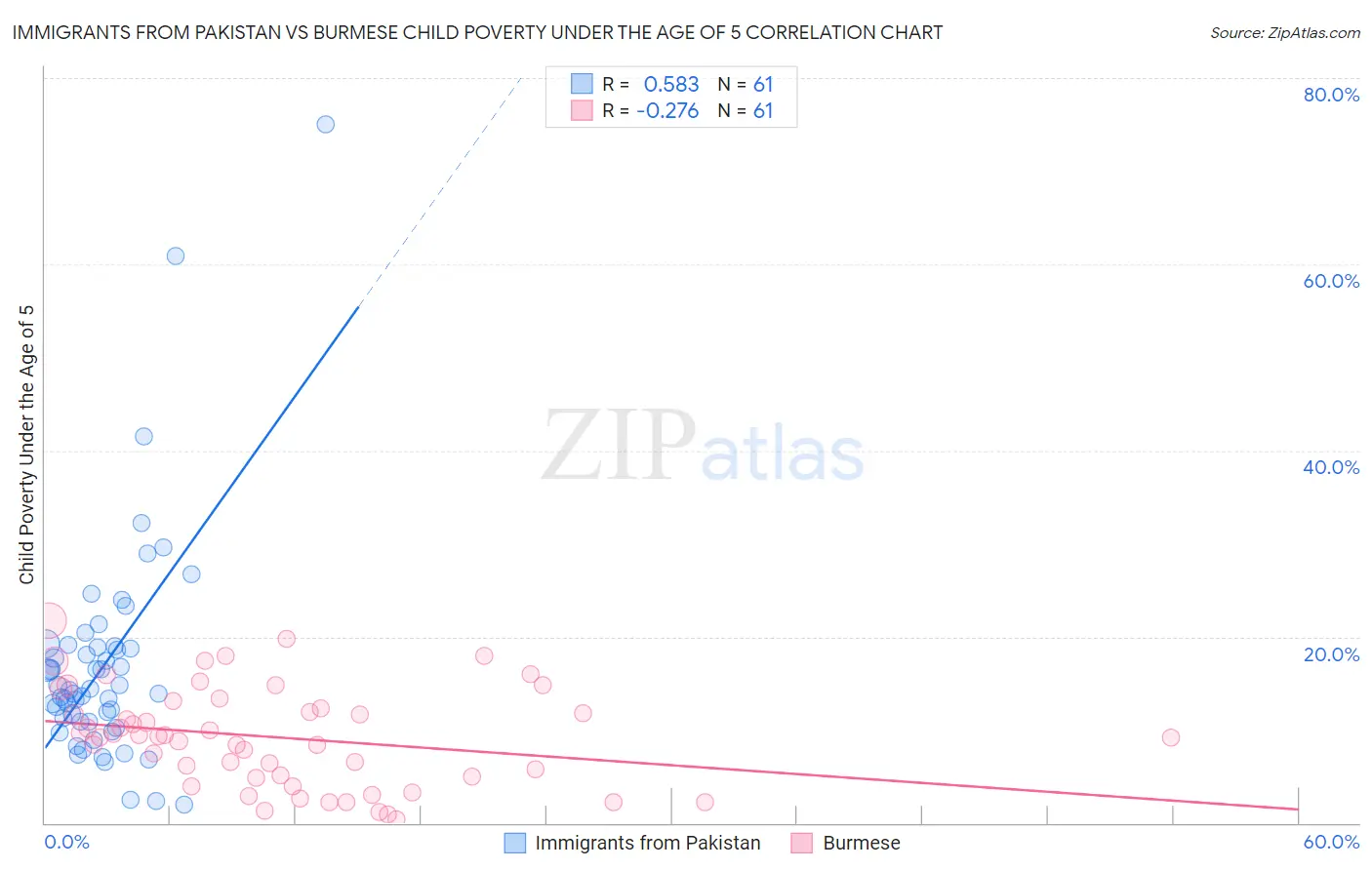Immigrants from Pakistan vs Burmese Child Poverty Under the Age of 5
COMPARE
Immigrants from Pakistan
Burmese
Child Poverty Under the Age of 5
Child Poverty Under the Age of 5 Comparison
Immigrants from Pakistan
Burmese
14.9%
CHILD POVERTY UNDER THE AGE OF 5
99.4/ 100
METRIC RATING
56th/ 347
METRIC RANK
13.2%
CHILD POVERTY UNDER THE AGE OF 5
100.0/ 100
METRIC RATING
10th/ 347
METRIC RANK
Immigrants from Pakistan vs Burmese Child Poverty Under the Age of 5 Correlation Chart
The statistical analysis conducted on geographies consisting of 274,479,981 people shows a substantial positive correlation between the proportion of Immigrants from Pakistan and poverty level among children under the age of 5 in the United States with a correlation coefficient (R) of 0.583 and weighted average of 14.9%. Similarly, the statistical analysis conducted on geographies consisting of 442,195,758 people shows a weak negative correlation between the proportion of Burmese and poverty level among children under the age of 5 in the United States with a correlation coefficient (R) of -0.276 and weighted average of 13.2%, a difference of 12.9%.

Child Poverty Under the Age of 5 Correlation Summary
| Measurement | Immigrants from Pakistan | Burmese |
| Minimum | 2.0% | 0.42% |
| Maximum | 75.0% | 21.8% |
| Range | 73.0% | 21.3% |
| Mean | 16.9% | 9.2% |
| Median | 14.3% | 9.3% |
| Interquartile 25% (IQ1) | 10.9% | 4.9% |
| Interquartile 75% (IQ3) | 18.9% | 12.7% |
| Interquartile Range (IQR) | 8.0% | 7.8% |
| Standard Deviation (Sample) | 12.0% | 5.3% |
| Standard Deviation (Population) | 11.9% | 5.2% |
Similar Demographics by Child Poverty Under the Age of 5
Demographics Similar to Immigrants from Pakistan by Child Poverty Under the Age of 5
In terms of child poverty under the age of 5, the demographic groups most similar to Immigrants from Pakistan are Danish (14.9%, a difference of 0.070%), Egyptian (14.9%, a difference of 0.080%), Immigrants from Israel (14.9%, a difference of 0.13%), Swedish (15.0%, a difference of 0.13%), and Luxembourger (14.9%, a difference of 0.14%).
| Demographics | Rating | Rank | Child Poverty Under the Age of 5 |
| Immigrants | Bulgaria | 99.6 /100 | #49 | Exceptional 14.8% |
| Immigrants | Northern Europe | 99.6 /100 | #50 | Exceptional 14.8% |
| Estonians | 99.6 /100 | #51 | Exceptional 14.8% |
| Immigrants | Serbia | 99.5 /100 | #52 | Exceptional 14.9% |
| Luxembourgers | 99.4 /100 | #53 | Exceptional 14.9% |
| Immigrants | Israel | 99.4 /100 | #54 | Exceptional 14.9% |
| Danes | 99.4 /100 | #55 | Exceptional 14.9% |
| Immigrants | Pakistan | 99.4 /100 | #56 | Exceptional 14.9% |
| Egyptians | 99.4 /100 | #57 | Exceptional 14.9% |
| Swedes | 99.4 /100 | #58 | Exceptional 15.0% |
| Paraguayans | 99.4 /100 | #59 | Exceptional 15.0% |
| Immigrants | Russia | 99.3 /100 | #60 | Exceptional 15.0% |
| Immigrants | Poland | 99.1 /100 | #61 | Exceptional 15.1% |
| Immigrants | Eastern Europe | 99.1 /100 | #62 | Exceptional 15.1% |
| Immigrants | Europe | 99.1 /100 | #63 | Exceptional 15.1% |
Demographics Similar to Burmese by Child Poverty Under the Age of 5
In terms of child poverty under the age of 5, the demographic groups most similar to Burmese are Immigrants from Korea (13.2%, a difference of 0.11%), Immigrants from South Central Asia (13.3%, a difference of 0.21%), Bhutanese (13.4%, a difference of 0.96%), Immigrants from Iran (13.1%, a difference of 1.1%), and Iranian (13.1%, a difference of 1.3%).
| Demographics | Rating | Rank | Child Poverty Under the Age of 5 |
| Filipinos | 100.0 /100 | #3 | Exceptional 11.6% |
| Thais | 100.0 /100 | #4 | Exceptional 12.3% |
| Immigrants | Hong Kong | 100.0 /100 | #5 | Exceptional 12.4% |
| Immigrants | Singapore | 100.0 /100 | #6 | Exceptional 12.9% |
| Chinese | 100.0 /100 | #7 | Exceptional 13.1% |
| Iranians | 100.0 /100 | #8 | Exceptional 13.1% |
| Immigrants | Iran | 100.0 /100 | #9 | Exceptional 13.1% |
| Burmese | 100.0 /100 | #10 | Exceptional 13.2% |
| Immigrants | Korea | 100.0 /100 | #11 | Exceptional 13.2% |
| Immigrants | South Central Asia | 100.0 /100 | #12 | Exceptional 13.3% |
| Bhutanese | 100.0 /100 | #13 | Exceptional 13.4% |
| Okinawans | 100.0 /100 | #14 | Exceptional 13.4% |
| Indians (Asian) | 100.0 /100 | #15 | Exceptional 13.4% |
| Immigrants | Eastern Asia | 100.0 /100 | #16 | Exceptional 13.5% |
| Assyrians/Chaldeans/Syriacs | 100.0 /100 | #17 | Exceptional 13.6% |